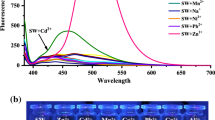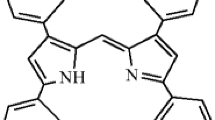Abstract
A novel donor–acceptor fluorescent sensor was designed and synthesized. The sensor exhibited high selectivity and sensitivity to Zn2+ in acetonitrile solution. When 3.0 equiv. of Zn2+ was added gradually, the emission intensity at 500 nm increased 54-fold, accompanied by the fluorescent color of the solution changed from dark to green. Job’s plot and ESI-MS were carried out to verify a 1:1 stoichiometric complex was formed between the sensor and Zn2+. The limit of detection (LOD) to Zn2+ was measured to be 2.81 × 10−9 mol L−1. Moreover, the sensor not only could be used to detect Zn2+ in practical water samples with high accuracy, but also could be made into test paper for the qualitative detection for Zn2+.








Similar content being viewed by others
References
Jomova K, Valko M (2011) Advance in metal-induced oxidative stress and human disease. Toxicology 283:65–87
Duruibe JO, Ogwuegbu MOC, Egwurugwu JN (2007) Heavy metal pollution and human biotoxic effect. Int J Phys Sci 2(5):112–118
Vallee BL, Falchuk KH (1993) The biochemical basis of zinc physiology. Physiol Rev 73:79–118
Berg JM, Shi YG (1996) The galvanization of biology: a growing appreciation for the roles of zinc. Science 271:1081–1085
Xie XM, Smart TG (1991) A physiological role for endogenous zinc in rat hippocampal synaptic neurotransmission. Nature 349:521–524
Jin YZ, Wang S, Zhang YJ, Song B (2016) Highly selective fluorescent chemosensor based on benzothiazole for detection of Zn2+. Sensors Actuators B Chem 225:167–173
Andreini C, Banci L, Bertini I, Rosato A (2006) Zinc through the three domains of life. J Proteome Res 5:3173–3178
Wu GF, Gao Q, Li MX, Tang X, Tong QX (2018) A Ratiometric probe based on coumarin-quinoline for highly selective and sensitive detection of Zn2+ ions in living cells. J Photochem Photobiol A Chem 355:487–495
Erdemir S, Tabakci B (2017) Selective and sensitive fluorescein-benzothiazole based fluorescent sensor for Zn2+ ion in aqueous media. J Fluoresc 27:2145–2152
Guang SY, Wei G, Yan ZQ, Zhang YH, Zhao G, Wu RL, Xu HY (2018) A novel turnon fluorescent probe for multi-channel detection of Zn2+ and Bi3+ with different action mechanisms. Analyst 143:449–457
Upadhyay Y, Anand T, Babu LT, Paira P, Crisponi G, Kumar A, Sahoo SK (2018) Three-in-one type fluorescent sensor based on a pyrene pyridoxal cascade for the selective detection of Zn(II) hydrogen phosphate and cysteine. Dalton Trans 47:742–749
Maji A, Pal S, Lohar S, Mukhopadhyay SK, Chattopadhyay P (2017) A new turn-on benzimidazole based greenish-yellow fluorescent sensor for Zn2+ ion at biological pH applicable in cell imaging. New J Chem 41:7583–7590
Kwon JE, Lee S, You Y, Baek KH, Ohkubo K, Cho J, Fukuzumi S, Shin I, Park SY, Nam W (2012) Fluorescent zinc sensor with minimized proton-induced interferences: photophysical mechanism for fluorescence turn-on response and detection of endogenous free zinc ions. Inorg Chem 51:8760–8774
Domaille DW, Que EL, Chang CJ (2008) Synthetic fluorescent sensors for studying the cell biology of metals. Nat Chem Biol 4:168–175
Hong YN, Chen SJ, Leung CW, Lam JW, Liu JZ, Seng T, Kwok RT, Yu Y, Wang ZK, Tang BZ (2011) Fluorogenic Zn (II) and chromogenic Fe (II) sensors based on terpyridine-substituted tetraphenylethenes with aggregationinduced emission characteristics. ACS Appl Mater Interfaces 3:3411–3418
Ding L, Cheng W, Wang XJ, Ding SJ, Ju HX (2008) Carbohydrate monolayer strategy for electrochemical assay of cell surface carbohydrate. J Am Chem Soc 130:7224–7225
Guo Z, Park S, Yoon J, Shin I (2014) Recent progress in the development of near-infrared fluorescent probes for bioimaging applications. Chem Soc Rev 43(1):16–29
Wu Z, Zhang Y, Ma JS, Yang G (2006) Ratiometric Zn2+ sensor and strategy for Hg2+ selective recognition by central metal ion replacement. Inorg Chem 45:3140–3142
Ghaedi M, RezaFathi M, Shokrollahi A, Shajarat F (2006) Highly selective and sensitive preconcentration of mercury ion and determination by cold vapor atomic absorption spectroscopy. Anal Lett 39:1171–1185
Willemse CM, Tlhomelang K, Jahed N, Baker PG, Iwuoha EI (2011) Metallo-graphene nanocomposite electrocatalytic platform for the determination of toxic metal ions. Sensors 11:3970–3987
Ghorai P, Pal K, Karmakar P (2020) The development of two fluorescent chemosensors for the selective detection of Zn2+ and Al3+ ions in a quinoline platform by tuning the substituents in the receptor part: elucidation of the structures of the metal-bound chemosensors and biological studies. Dalton Trans 49:4758–4773
Kim A, Lee H, Yun D, Jung U, Kim K-T, Kim C (2020) Developing a new chemosensor targeting zinc ion based on two types of quinoline platform. Spectrochim Acta A Mol Biomol Spectrosc 241:118652
Hu JH, Sun Y, Qi J, Li Q, Wei TB (2017) A new unsymmetrical azine derivative based on coumarin group as dual-modal sensor for CN− and fluorescent “OFF-ON” for Zn2+. Spectrochim Acta A 175:125–133
Sarkar D, Pramanik AK, Mondal TK (2015) A novel coumarin based molecular switch for dual sensing of Zn (II) and Cu (II). RSC Adv 5:7647–7653
Wechakorna K, Suksen K, Piyachaturawat P, Kongsaeree P (2016) Rhodamine-based fluorescent and colorimetric sensor for zinc and its application in bioimaging. Sensors Actuators B Chem 228:270–277
Pu SZ, Jiang DH, Liu WJ, Liu G, Cui SQ (2012) Multi-addressable molecular switches based on photochromic diarylethenes bearing a rhodamine unit. J Mater Chem 22:3517
Dong L, Zang Y, Zhou D, He XP, Chen GR, James TD, Li J (2015) Glycosylation enhances the aqueous sensitivity and lowers the cytotoxicity of a naphthalimide zinc ion fluorescence probe. Chem Commun 51:11852–11855
Lee SK, Choi MG, Choi J, Chang SK (2015) Fluorescence signaling of Zn2+ levels in synthetic urine dipicolylamine-armed hydroxynaphthalimide. Sensors Actuators B Chem 207:303–307
Rezaeian K, Khanmohammadi H, Talebbaigy A (2020) Detection of CN−, Cu2+and Zn2+ ions using a new chromone-based colorimetric chemosensor: half-adder and integrated circuits. Anal Methods 12:1759–1766
Xu YK, Zhao SF, Zhang YX, Wang HY, Yang XF, Pei MS, Zhang GY (2020) A selective “turn-on” sensor for recognizing In3+and Zn2+in respective systems based on imidazo [2,1-b] thiazole. Photochem Photobiol Sci 19:289–298
Erdemir S, Tabakci B (2018) Highly sensitive fluorometric detection of Zn2+ ion by calix [4] arene derivative appended 4-biphenylcarbonitrile. Dyes Pigments 151:116–122
Yang YS, Ma CM, Zhang YP, Xue QH, Ru JX, Liu XY, Guo HC (2018) A highly selective “turn-on” fluorescent sensor for zinc ion based on a cinnamyl pyrazoline derivative and its imaging in live cells. Anal Methods 10:1833–1841
Mandal T, Hossain A, Dhara A, Masum AA, Konar S, Manna SK, Seth SK, Pathak S, Mukhopadhyay S (2018) Terpyridine derivative as “turn-on” fluorescent chemosensor for the selective and sensitive detection of Zn2+ ions in solution and in live cells. Photochem Photobiol Sci 17:1068–1074
Gogoi A, Samanta S, Das G (2014) A benzothiazole containing CHEF based fluorescence turn-ON sensor for Zn2+ and Cd2+ and subsequent sensing of H2PO4− and P4O74− in physiological pH. Sensors Actuators B Chem 202:788–794
Heo J, Hwang CS (2015) Application of the water-dispersible ZnS: Mn nanocrystal as an effective and convenient photosensor material for the detection of Zn2+ and Cd2+ ions in aqueous solution. Bull Kor Chem Soc 36:2411–2412
Yao PS, Liu ZH, Ge JZ, Chen Y, Cao QY (2015) A novel polynorbornene-based chemosensor for the fluorescence sensing of Zn2+ and Cd2+ and subsequent detection of pyrophosphate in aqueous solutions. Dalton Trans 44:7470–7476
Pu SZ, Sun Q, Fan CB, Wang RJ, Liu G (2016) Recent advances in diarylethene-based multi-responsive molecular switches. J Mater Chem C 4(15):3075–3093
Fan C, Huang X, Black CA (2015) A fast-response fluorescent “turn-on” chemosensor for selective detection of Cr3+. RSC Adv 5(86):70302–70308
Luxami V, Verma M, Rani R (2012) FRET-based ratiometric detection of Hg2+ and biothiols using naphthalimide-rhodamine dyads. Org Biomol Chem 10(40):8076–8081
Irie M (2000) Diarylethenes for memories and switches. Chem Rev 100(5):1685–1716
Irie M, Sakemura K, Okinaka M, Uchida K (1995) Photochromism of dithienylethenes with electron-donating substituents. J Organomet Chem 60(25):8305–8309
Aher NG, Pore VS, Mishra NN (2009) Synthesis and antifungal activity of 1, 2, 3-triazole containing fluconazole ana1ogues. Bioorg Med Chem Lett 19(3):759–763
Feng YF, Lei J, Fu DX (2003) a new triazole antifungail drug. Chin J New Drugs 12(1):27–29
Singh AK, Pandey OP, Sengupta SK (2012) Synthesis, spectral characterization and biological activity of zinc(II) complexes with 3-substituted phenyl-4-amino-5-hydrazino-1, 2, 4-triazole Schiff bases. Spectrochim Acta A 85:1–6
Singh K, Barwa MS, Tyagi PS (2007) Synthesis and characterization of cobalt(II), nickel(II), copper(II) and zinc(II) complexes with schiff base derived from 4-amino-3-mercapto-6-methyl-5-oxo-1, 2, 4-triazine. Eur J Med Chem 42:394–402
Marzieh A, Seyed JF, Masoud TM, Hassan H (2014) DNA- and BSA-binding studies and anticancer activity against human breast cancer cells (MCF-7) of the zinc(II) complex coordinated by 5, 6-diphenyl-3-(2-pyridyl)-1, 2, 4-triazine. Spectrochim Acta A Mol Biomol Spectrosc 127:511–520
Shi F, Cui SQ, Liu HL, Pu SZ (2020) A high selective fluorescent sensor for Cu2+ in solution and test paper strips. Dyes Pigments 173:107914
Ding H, Li B, Pu S, Liu G, Jia D, Zhou Y (2017) A fluorescent sensor based on a diarylethene-rhodamine derivative for sequentially detecting Cu2+ and arginine and its application in keypad lock. Sensor Actuat B-Chem 247:26–35
Li J, Yin C, Huo F (2016) Development of fluorescent zinc chemosensors based on various fluorophores and their applications in zinc recognition. Dyes Pigments 131:100–133
Huang S, Clark RJ, Zhu L (2007) Highly sensitive fluorescent probes for zinc ion based on Triazolyl-containing Tetradentate coordination motifs. Org Lett 9:4999–5002
Woo H, Cho S, Han Y, Chae WS, Ahn DR, You Y, Nam W (2013) Synthetic control over Photoinduced Electron transfer in phosphorescence zinc sensors. J Am Chem Soc 135:4771–4787
Li G, Ma L, Liu G, Fan CB, Pu S (2017) A diarylethene-based “on–off–on” fluorescence sensor for the sequential recognition of mercury and cysteine. RSC Adv 7(33):20591–20596
Wang H, Wang B, Shi Z, Tang X, Dou W, Han Q (2015) A two-photon probe for Al3+ in aqueous solution and its application in bioimaging. Biosens Bioelectron 65:91–96
Qu S, Zheng C, Liao G, Fan C, Liu G, Pu S (2017) A fluorescent chemosensor for Sn2+ and Cu2+ based on a carbazole-containing diarylethene. RSC Adv 7(16):9833–9839
Wu X, Chen J, Zhao JX (2013) A reversible fluorescent logic gate for sensing mercury and iodide ions based on a molecular beacon. Analyst 138(18):5281–5287
Acknowledgements
The authors are grateful for the financial support from the National Natural Science Foundation of China (41867053), the Project of the Science Funds of the Education Office of Jiangxi Province (GJJ190599), the Young Talents Project of Jiangxi Science and Technology Normal University (2015QNBJRC004), the Monster’ Innovative Foundation of Jiangxi Science and Technology Normal University (YC2019-S410).
Author information
Authors and Affiliations
Corresponding authors
Additional information
Publisher’s Note
Springer Nature remains neutral with regard to jurisdictional claims in published maps and institutional affiliations.
Electronic supplementary material
ESM 1
(DOC 345 kb)
Rights and permissions
About this article
Cite this article
Jiang, G., Shi, F., Jia, Y. et al. A Novel Donor–Acceptor Fluorescent Sensor for Zn2+ with High Selectivity and its Application in Test Paper. J Fluoresc 30, 1567–1574 (2020). https://doi.org/10.1007/s10895-020-02609-9
Received:
Accepted:
Published:
Issue Date:
DOI: https://doi.org/10.1007/s10895-020-02609-9




